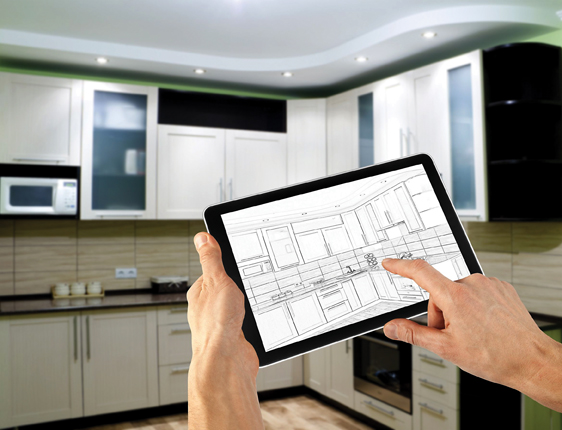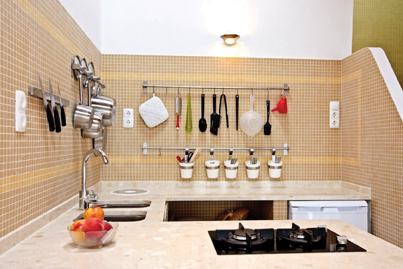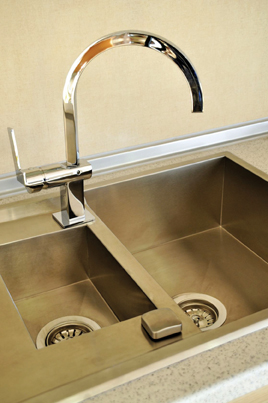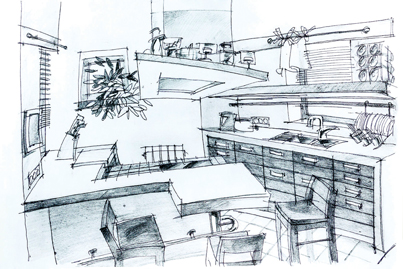Home Improvement: Your Dream Kitchen
Posted on May 1, 2014 by bob in Features
by Matthew M.F. Miller
The kitchen is high on the list of favorite rooms to remodel, but a full-fledged makeover is fraught with peril. These 12 steps from the National Association of the Remodeling Industry, Des Plaines, Ill., can help you avoid trouble spots and end up with the kitchen of your dreams.
1. Take Time to Plan
Planning is a critical step in any remodeling project, and never more important than in the kitchen. The first step starts with a critique of your current setup. What works? What doesn’t? Think about ways you prepare food now, or how you might in the future. Will you have more than one cook preparing meals at one time? Do you prefer cooking a special type of cuisine that requires more counter or storage space? The most effective design accommodates the way you actually work and live in the kitchen.
2. Think Task, Think Foot-Friendly
The floor plan is key to great kitchen design. The most efficient layout of elements allows you and your family to cook and use the room with ease and comfort. Traditionally, designers group common elements in a work triangle or station. You could have a preparation/cooking station with a separate clean-up area. The clean-up work triangle could include a dishwasher, sink, counter space and recycling center. These elements would be close to one another for maximum efficiency. The goal is to minimize the number of steps between various tasks and to avoid unnecessarily crossing the kitchen. Keep in mind how traffic flows through the room. Kids and family members traipsing through your work triangle reduce the efficiency of the space.

3. Get Beyond the Blueprints
Refuse to join the “I-Didn’t-Know-It-Would-Look-Like-That” club. It is imperative you understand what your plans will look like when constructed. Most homeowners have trouble envisioning what a room will look like based on a flat line drawing. A three- dimensional design plan generated on a computer can help, but there’s no substitute for real-life examples. Visit a showroom with life-sized models of various rooms and products. Sketch out a full-scale outline of your kitchen plan in chalk on your garage or basement floor. For colored items, ask to see a large section of the available hues before ordering. Bold colors can look great on a small scale, but they can quickly overwhelm you when covering a large surface. Don’t rely on your imagination for these important decisions.
 4. Collect Ideas and Options
4. Collect Ideas and Options
There’s nothing worse than finishing a remodeling project only to discover the perfect detail you wished you had added. Take the time to research all of your options. Make it your business to know what’s on the market and what’s coming soon. Investigate products. Find out the pros and cons of various options. Clip photos of layouts that inspire or excite you. Allow yourself the luxury of considering a number of design possibilities. You’ll live with your decisions a long time.
5. Don’t Skimp on Storage
Is your good china stored in a bedroom closet? Are you tired of stuffing those extra plastic containers in odd nooks and corners? This is the time to inventory the types of items you want to store in the kitchen, including those items you’ve “temporarily” stashed in the attic and basement. Decide what you want to store and where you want to store it. There are many innovative new cabinet accessories designed with efficient storage in mind. For maximum efficiency, link storage with your work stations, placing spice containers, for example, within easy reach of the cooktop.
6. Safety Matters
Safety should be a primary concern in the kitchen. Carefully consider the potential hazards in your kitchen design. An oven next to a hallway, for example, puts someone at risk for stumbling into an open oven door. Investigate some of the new “smart home” technology, such as ovens with lockout features and “universal design” products that are user-friendly across generations and for a range of physical abilities.
7. Light Up Your Life
Don’t wait until the project is over to determine that your kitchen is too dark. While you may consider lighting to be the finishing touch for your room, it’s among the earliest decisions you must make, since the wiring needs to be installed in the walls, behind the cabinets. Plan to use three forms of lighting in your kitchen: ambient, task and accent. Ambient lighting illuminates the entire room. Task lighting illuminates only one area for a specific task – such as under-cabinet lighting over a countertop. Accent lights highlight an interesting feature or item, such as a prized china collection. Decide on the moods you want to create in your kitchen – romantic, functional, fun – and create a lighting design that matches those moods.
8. Set Priorities
Even dream kitchens can’t have everything. You must set priorities for your project based on the size of your kitchen and the size of your budget. Decide what elements you absolutely need in your kitchen, which you would like to have, and which ones are, well, a daydream. In most cases, not everything you wish for will fit. In a small kitchen it may be impossible to install an island and maintain proper clearances. Should you expand the room in order to accommodate your dream? List your wishes, wants and needs, then prioritize each item. You may find that a bump out is necessary to meet your needs, or you may find that you can live without the island or second cooktop.
9. Know When to Say ‘When’
It’s easy to blow your budget in the thick of remodeling. Decide what you can afford before you start designing. Always refer to the cold, hard numbers of your budget before making a product or design decision. Remember, no matter what you decide to spend, you’ll be tempted by a higher-end, more costly option somewhere along the line. Beware the phrases, “While we’re at it, why don’t we…” or “A little more on this faucet won’t make any difference,” or, “It’s only $20 more.” Seek out designers, suppliers and contractors who are willing to work with your budget, not against it.
 10. Don’t Work Against the Clock
10. Don’t Work Against the Clock
Remodeling contractors say the No. 1 question they’re asked is: “How long will it take?” Ask your contractor for a specific date for the start and substantial completion of the project, but don’t turn target dates into rigid deadlines. Remain flexible. Your renovation may be affected by changes, unexpected occurrences or material delays. Never launch a project before a major event in the home, such as a wedding or holiday gathering.
11. Beware of Change
When you ask for something to be changed, there will be a delay and a cost. The same holds true for unexpected events, such as newly discovered termites. You should control the number of changes that you initiate during a project. If you want to make a change, ensure that the change is made in writing and that it is signed by both parties before work begins. Ask for a revised timetable and budget in the event of any changes or unexpected occurrences.
12. Take Time to Prepare
You need to prepare for two things during a kitchen remodeling: the construction phase and the inconvenience of being without a kitchen for a period of time. Pack your kitchen items in clearly labeled boxes that can be moved to another part of the home during the project. Set aside items you will need every day, such as your coffeemaker, filters and mugs. Remove fragile items from the walls in neighboring rooms.
© CTW Features










